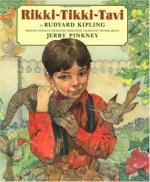|
This section contains 1,873 words (approx. 5 pages at 400 words per page) |

|
Fernando is a freelance writer and editor based in Seattle, Washington. In this essay, Fernando explores Kipling's use of snake symbolism to promote British imperialism.
"Rikki-Tikki-Tavi," Rudyard Kipling's famous children's story about the battle between a mongoose and two cobras, seems to be a straightforward tale in which the hero and villains are clearly defined and good triumphs over evil. However, like most stories that deal with such themes, the methods by which good and evil are defined and represented can serve to make a greater ideological point. Kipling, who wrote during the height of British imperial power, was a well-known proponent of British imperialism, and his ideologies were not absent from his children's stories. In the case of "Rikki-Tikki-Tavi," Kipling uses the cobras, Nag and Nagaina, as a symbol of evil in order to demonize the Hindu culture and thereby promote the British agenda of rule...
|
This section contains 1,873 words (approx. 5 pages at 400 words per page) |

|




